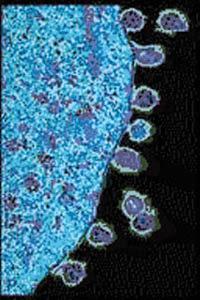Interruption of antiretroviral therapy of virally suppressed HIV+ individuals, leads to replication of the viral reservoir found in CD4 T cells.This represents a significant hurdle in achieving HIV cure. One of the cure strategies is to activate latently infected cells making them more susceptible to immune-mediated clearance, eliminating the viral reservoir. However, evidence that this is achievable has not yet been reported.
Potent HIV-1 broadly neutralising antibodies (bNAbs) have been shown to reduce viremia in untreated non-human primates, and delay the onset of viral rebound in HIV-1 infected individuals. These studies demonstrate that bNAbs have the ability to control virus. However, antibody mediated clearance of the viral reservoir has not been described.
Borducchi et al., aimed to evaluate the capacity of the potent neutralising antibody (NAb) PGT121 and the TLR7 agonist vesatolimod (GS-9620) to target the viral reservoir in ART- suppressed Simian-HIV (SHIV) -infected rhesus monkeys. Researchers treated virally suppressed monkeys (due to ART) with either NAbs, TLR7-agonist or a combination of both. Upon completion of immunotherapy followed by a 5 week wash out period, ART was discontinued and viral rebound was monitored. Borducchi et al., observed that only co-adminstration of NAbs and the TLR-7 agonist resulted in viral suppression of 55% of the treated monkeys port ART discontinuation.
Finally, to determine if treatment resulted in elimination of the viral reservoir, they adoptively transferred CD4+ T cells from virally suppressed monkeys to SHIV naïve monkeys. No viral replication was observed in the naïve monkeys, illustrating that immunotherapy successfully cleared the latent reservoir in virally suppressed monkeys.
In summary, Borducchi et al., provided a proof of concept study where NAb and TLR7 agonist treatment can successfully delay viral rebound following ART discontinuation. TLR-7 agonists activates CD4 T cells allowing replication of the viral reservoir, and making them more susceptible to immune control. TLR-7 agonist also activates natural killer cells and monocyets, which participate together with other effector cells in Antibody mediated control of viral replication.
Article: Borducchi et al., 2018. Antibody and TLR7 agonist delay viral rebound in SHIV-infected monkeys. Nature
Article by Cheleka AM Mpande











